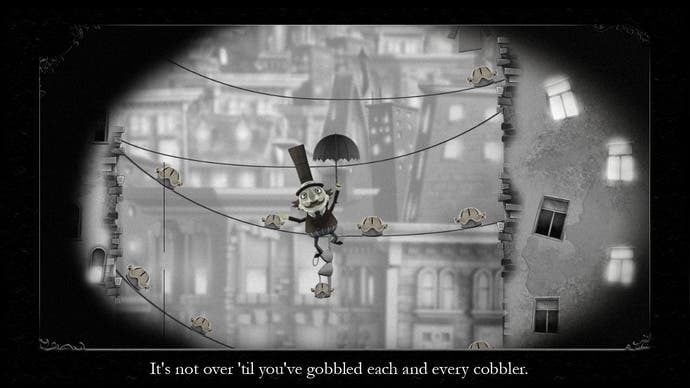The Misadventures of P. B. Winterbottom
Yes we flan.
With a squeeze of the right trigger, however, you can record the platforming antics you put him through before releasing it to replay the action with a clone. The clone loops endlessly, while a simple counter in the corner tells you how many copies you're allowed to have running about at any one time. You can get rid of them with a sharp smack from your umbrella, or even boot them around the environment with comic and often useful results.
Winterbottom is surprisingly imaginative with its clones. In early puzzles you might clone yourself standing on a pressure switch to act as a paperweight while you sneak past a spring-loaded door, as in every game ever. But then you might clone yourself lashing out with the umbrella, and subsequently use your clone to smack you across an unjumpable gap, like a tubby home run.
You can clone yourself to power the other half of seesaws, or to activate distant switches while you linger elsewhere, and you can even jump up on top of stacked clones, using Winterbottom's dandy topper as a makeshift platform.
Alongside all of this, the game piles up dozens of smart complications. There are levels where switches, springs and levers mean that Winterbottom reaches a Lemmings-like complexity, and sparse levels where pies hover impossibly out of reach until you crack the design's devious secret.

There are levels where the pies appear only briefly, after the flick of a switch, levels where they must be collected in sequence, levels where only clones can interact with the environment, levels which spawn nasty red evil Winterbottoms, and long gauntlet levels where dozens of clones spill out over rivers and steep drops, with only a limited amount of recording time available.
Despite the care lavished on the learning curve, there are moments when Winterbottom will simply stop you dead, with no means of progression. Often the key to a puzzle is finding just the right spot to place a clone and, at times, the austere logic lurking behind the pretty stylings can make the whole thing seem daunting. There's even the odd level where you work out what to do fairly early on, but subsequently implementing it all can seem like a bit of a faff and a chore.
Yet the thrill of getting the most elegant solution to a tricky problem will power you through in the end. And while the finely-minted challenges mean that there isn't a huge degree of replayability in the central campaign unless you're some kind of lateral-thinking genius, there's a range of bonus stages to tackle: knockabout arenas that dramatically up the pie quotient before grading you for time taken and number of clones used.
What's perhaps most astonishing about the whole thing is the fact that, despite the game's fierce indie credibility and time-twisting preoccupations, the ghost of Braid refuses to haunt Winterbottom. This is, above all else, a supremely confident game: confident in its charm, in its challenges, and in its unique identity. If you thought Braid gave puzzle-platformers a soul, this one is all about personality.








